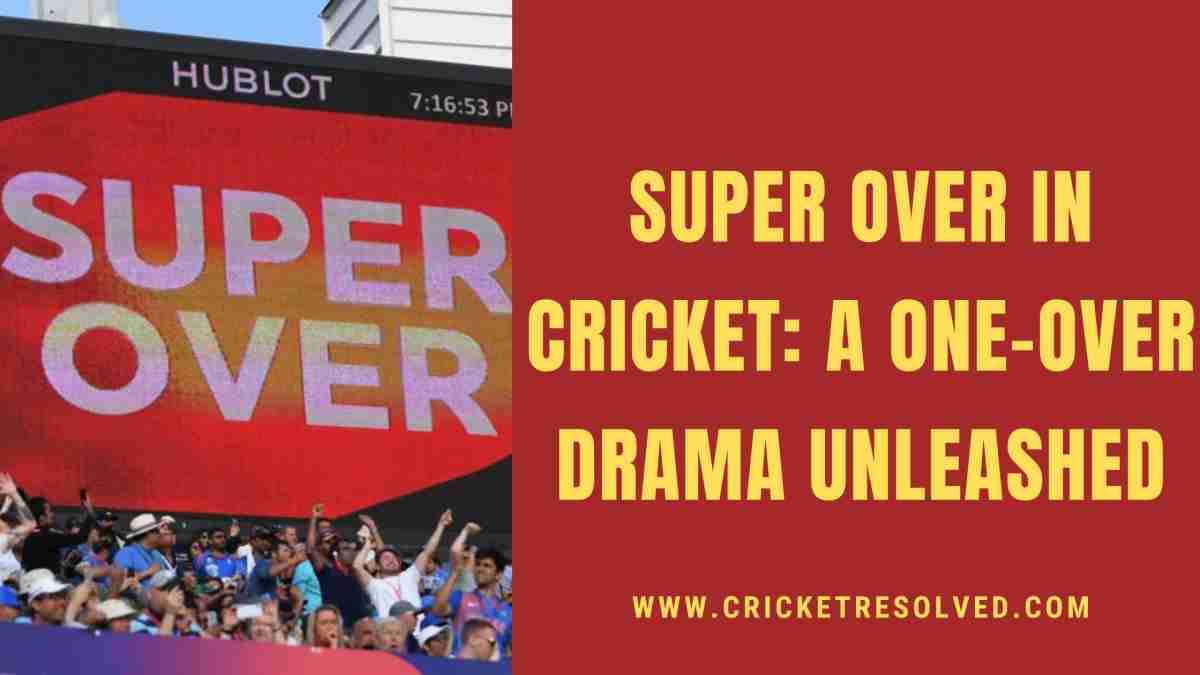
Cricket often captivates fans with its thrilling finishes and nail-biting encounters. In recent years, the arrival of the “Super Over” has added an extra dose of excitement to the game.
I am sure you must have seen some intense Super Overs in cricket matches. And it’s the perfect recipe to add some spice to an already gripping match.
This article aims to provide you with a comprehensive understanding of the Super Over in cricket, its rules, and its significance.
What is a Super Over in Cricket?
This method works as a tie-breaker. The Super Over helps in determining the winner in case of a tie in T20I and ODI matches.
Both teams can play an additional over, and the team that scores more runs wins the match.
But before introducing this method, the ICC used a different rule to determine the winner. So, what was the rule?
How did Super Over Came to be?
Before Super Over’s introduction, another method was used. It was known as “Bowl Out”.
The bowl out was like a penalty shootout in a football match. Teams select five players, and they have a go at hitting the wickets alternately. So the team that hits the wickets the most wins the match.
A famous bowl out took place during a T20I World Cup match between India and Pakistan in 2007. The Indian team eventually went on to win the match. You can watch the video here for a better understanding of this method.
The bowl out was an interesting method, but it lacked a balance between bat and ball. So, in 2008, the ICC replaced the bowl out method with the Super Over.
Super Over in Different Formats
This method was first introduced in T20I cricket. All T20I matches are eligible for a Super Over if the match ends in a tie. This method is also applicable to all T20 domestic and franchise league matches, like IPL, BBL, CPL, etc.
Also Read: How Does the IPL Auction Work? – Explained
In ODI cricket, the Super Over was first introduced during the 2011 ICC Cricket World Cup. But it was exclusively reserved for the knockout stages.
Super Over was not applicable in other group matches of the World Cup or bilateral ODI matches. However, since June 2023, all ODI matches that end in a tie can determine a winner based on a Super Over.
And in Test cricket, there is no Super Over. I mean, there is no need for that, as there is less chance of a match resulting in a tie.
Rules of a Super Over
Let’s understand the rules.
Only Over Allowed
As the name suggests, both teams can play one over each. That means teams have 6 legitimate deliveries to score runs apart from wides, no balls, and any extras.
Which Team Bats First?
The team that bats in the second innings, gets the chance to bat first in the Super Over. Now they have an opportunity to set a competitive target for their opponents.
Batter and Bowlers
Both teams can nominate 3 batters for batting in the Super Over. So teams can play until they lose 2 wickets. Once the second wicket falls, they can’t bat further in the over.
On the other hand, teams can select one bowler who will bowl the complete over.
Choosing the Bowling End
As you must be aware, there are two ends on the wicket. Apart from selecting the bowler, both teams have the liberty to choose their preferred bowling end for the decisive over.
The Pitch
This decisive over happens on the same pitch that was used for the match.
Must Read: How Long is a Cricket Pitch?
What Happens if a Super Over Ends in a Tie?
Imagine this, a T20I match ends in a tie, then a Super Over takes place. But the Super Over also ends in a tie.
Now you must be wondering if it’s going to happen. Well, let me tell you this, a 2020 IPL match between Mumbai and Punjab went down the wire and saw a similar situation.
The match as well as the Super Over resulted in a tie. So, according to the new rules, teams played another over. Second Super Over? Yes. And Punjab won the match in that over.
The fans witnessed a thrilling match! Won’t believe me? Watch it for yourself here.
So, if the Super Over also ends in a tie, then another Super Over will take place. This process will continue until a team wins, of course, within a certain time.
However, before September 2019, the rules were different. If a Super Over ended in a tie, the team that had hit more boundaries was declared the winner.
This old rule was applied in the 2019 World Cup Final between England and New Zealand. After the Super Over resulted in a tie, England was declared as the champions based on the number of boundaries scored in the match.
A lot of cricket experts and fans criticized the ICC for this rule. Hence, in September 2019, the ICC changed the rules. Now, only Super Overs can determine the winners.
Consecutive Super Over Rule
In the case of consecutive Super Overs, there is one rule that needs to be followed.
A batter dismissed in the previous Super Over is not eligible to bat again in the next Super Over. The team then needs to nominate a different batter.
Similarly, the bowler who bowled the previous Super Over can’t bowl the next Super Over. Another bowler needs to bowl the next over.
First-Ever Super Over in International Cricket
This incident dates back to 2008. It took place in a T20I match between New Zealand and the West Indies.
The West Indies scored 25 runs thanks to Universe Boss Chris Gayle’s explosive batting. In response, New Zealand could only score 15 runs in 4 balls as they lost 2 wickets.
One thing to notice is that Sulieman Benn bowled a waist-high no ball to Ross Taylor. But the next delivery wasn’t a free hit. If the free hit rule had been there, then the result would have been different!
Conclusion
The Super Over has undoubtedly added a layer of excitement to the game of cricket. As cricket continues to evolve, this facet of the game promises to deliver many more captivating finishes, leaving fans in awe and players on the edge of their seats.
So, the next time you witness a tied match, brace yourself for the thrilling spectacle of the Super Over, where heroes are born and legends are made.
Read Next: The Powerplay Overs Rule in T20I Cricket – Explained










3 thoughts on “Super Over in Cricket: A One-Over Drama Unleashed”